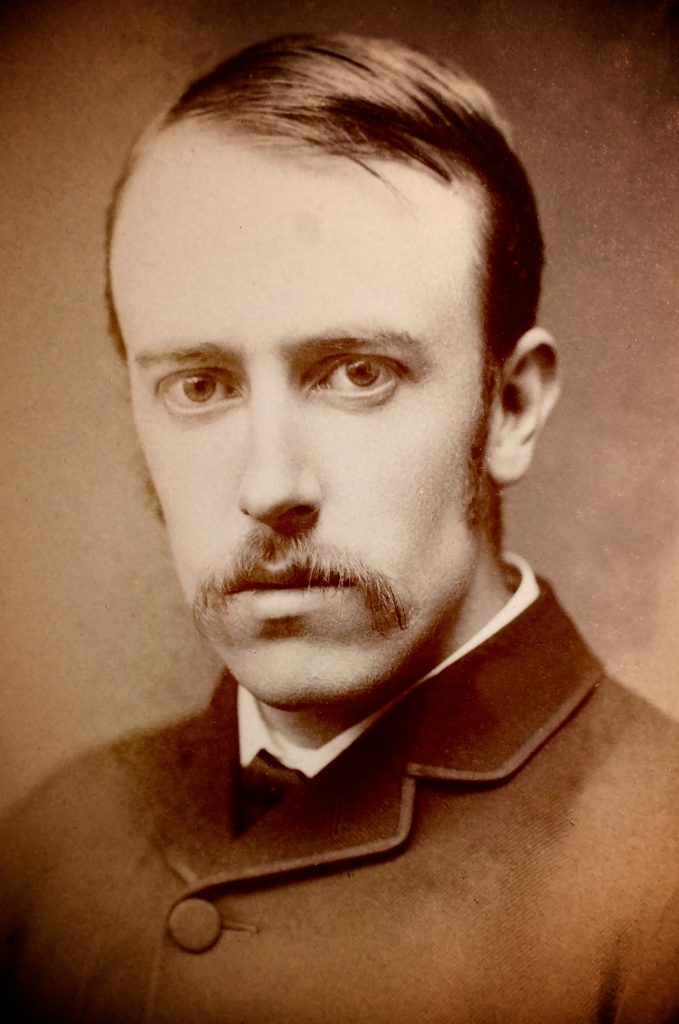
Archibald Cameron Corbett c 1880
ARCHIBALD CAMERON CORBETT:A MAN ON A MISSION
If you drive north-west out of Glasgow, up along the shores of Loch Lomond, then turn left towards Inveraray, you’ll come to a lovely little viewpoint on the highest part of the road, called ‘Rest and Be Thankful’. Behind you is towering Beinn Ime, one of the famous Munro mountains, and for nine miles south stretches a peninsula with several more hills, hemmed in between Loch Goil and Loch Long.
You’re in one of Scotland’s two National Parks, but the ground you’re standing on was given to the public nearly 100 years before either Park was created. The person who bought the 15,000-odd acres did so “…that our fellow citizens should have a mountain territory that will be their own for all time”.
If you were then to travel south 500 miles to south-east London, go around the Catford gyratory traffic system, and up a slight hill to the east of the Bromley Road, you’d find yourself amongst a large number of similar-looking houses, which came into being around the same time as the ‘mountain territory’ was given to the people of Glasgow. The two places could hardly be more different, but they are very much connected, and it could well be that the houses helped to pay for the mountains.
The connection is a man called Archibald Cameron Corbett, and the two places – the Ardgoil peninsula in Scotland, and a 3,000-property housing estate he called ‘St Germans’ – show two key facets of his character: on the one hand ‘probably the most prolific of London’s suburban developers in the 1890s and 1900s’ 1; and on the other a highly-respected philanthropist who gave away large amounts of land and money.
Corbett thought big: his London estates eventually amounted to over 10,000 houses and added to an already large fortune; he became a Member of Parliament involved in the key issues of the day – like Home Rule for Ireland; he was an ardent anti-drink campaigner; he was an advisor to numerous companies and social causes; he married a rich heiress; and he was eventually made a Lord. Above all though, he was an unshowy man of strong religious conviction, on a mission to improve society.
But why did he build all the houses? How did he get to be an MP? And what inspired his philanthropy? Let’s go back to Scotland in the mid-19th century, to a rather attractive sandstone house in the fashionable West End of Glasgow, where the Archibald Corbett story starts.
GROWING UP IN GLASGOW AND LONDON
He was born at No 8 Buckingham Terrace, Hillhead, on the 23rd May 1856. His father, Thomas Corbett, was descended from a long line of merchants and medics, and he was already a wealthy man. The Corbett side of the family hailed from the Gorbals area of central Glasgow, and had a highly-developed sense of obligation to the less fortunate – of whom there were a growing number as industrialization and slum living grew hand-in-hand in the ‘second city’ of the British Empire.
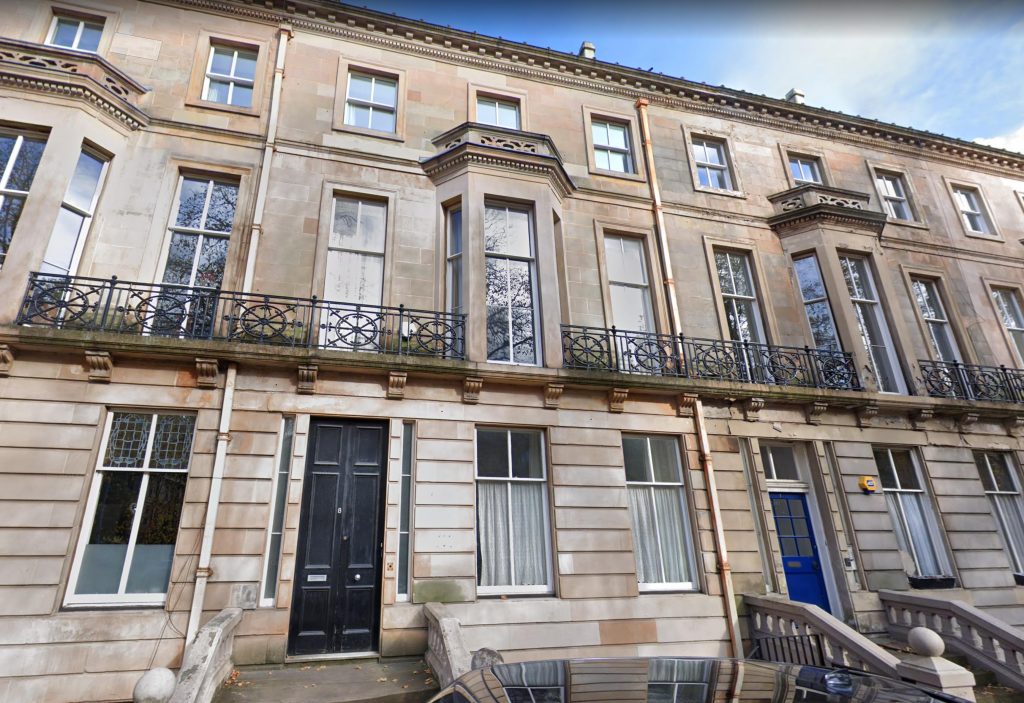
Buckingham Terrace in Glasgow, where Archibald Corbett was born
Young Archie’s mother, Sarah, was very different to his father. Her family, the Camerons, came from rural Lochaber, and had a strict Presbyterian background, believing that the Bible was the literal word of God. Sarah was deeply religious, and a model of respectability who distrusted any kind of frivolity. Archie and his elder brother Tom weren’t allowed to do anything that might smack of ‘pleasure-seeking’ and she even worried that they would be led astray by the temptations of school life, so they were educated by tutors at home – at least until Archibald was nine, when he was finally allowed to go to the nearby Glasgow Academy for a year.
Archie and Tom were joined by another brother, Harry, and a sister, Jessie, and the family moved several times within Glasgow to ever grander houses complete with a staff of servants to wait on them.
Archie’s father Thomas was the son of a Gorbals doctor, and had planned to be a lawyer, but ended up going into business trading in iron, timber and wool with his elder brother Andrew, who had emigrated to Australia. Sister Jessie said that her father “loved business as a game, but he loved humanity more and was a great philanthropist” 2. Already rich, in 1864 Thomas’s thirst for a new challenge – and presumably higher profits – took him away from Scotland too, but only as far as London, where the economy of the world’s biggest city was booming. He took an office in Gracechurch Street and a house in Clapham, and the rest of the family would soon follow him down there.
Archie would have been only ten or so years old, but the influence of his mother, father, and of Glasgow in general had already shaped his character for the rest of his life.
From his mother he learned piety, respectability and an emotional uptightness that he tried to correct when he had his own children. From his father he inherited a talent for business and a desire to help people: Thomas had given liberally to Glasgow charities, and had set up canteens where working men could get cheap meals. The city itself had left him with an abiding love of all things Scottish. He would marry a woman from nearby Paisley; he became an MP for one of Glasgow’s constituencies, and he took the title of Lord Rowallan of Ayrshire when he was elevated to the peerage. He also trusted the Scots above all others: his bankers were Scottish; his accountants were Scottish, and all the managers he employed on his housing developments hailed from the old country, much to the chagrin of his English employees.
But we’re getting ahead of ourselves. Let’s go back to Clapham in early 1870, where Archie is barely 14, and his father is about to spring a surprise on him and his brother Tom.
They were living in Oak Park, a grand-sounding house in Cavendish Road, just south of the Common when, according to family legend, Thomas called the boys in and offered them the choice of going to Oxford or Cambridge, or going on a Continental Tour. Archie and Tom chose the Tour, and at the start of March that year they and their parents set off for a seven-week trip round France and Italy. Fortunately for us one of the conditions of going on the tour must have been that Archie keep a diary of his impressions, and we get a lovely insight into his thoughts and feelings, particularly on art and architecture. The trip didn’t get off to a good start: “We left home about seven o’clock on the 5th March. It was a very disagreeable morning and we got into the train at Victoria Station and arrived at Dover about 12 o’clock. We then went on board the Prince Imperial and had a very stormy passage. Nearly all the passengers were sick and the waves were coming over the side”.
Things improved when they got to Paris: “We drove to the Grand Hotel which is the largest in the world. It has about 800 bedrooms. There is a large court in the centre covered with a high glass roof. Opening onto the court, there is a beautifully gilded reading room, and off the reading room there is a splendid dining hall, in which a ball took place while we were there.”
The family went sight-seeing around the city: “We drove to the Arc de Triomphe from which we had a view of Paris with its long lines of beautiful streets adorned with trees. This renders the view both interesting and beautiful …. we afterwards visited the Bois de Bologne which is a wood a short distance from Paris. Here there is a lovely lake in which there are some strange water velocipedes. Papa hired one of them”.
After a stop in Lyons, they arrived in Turin, where Archie wasn’t very impressed by the “unremarkable” Cathedral, but “adjoining it, however, there is a very interesting black marble chapel with a strange dome. The fine white marble statues come out in striking relief against the black walls …. Turin has a great many large and beautifully kept squares. The streets, though somewhat narrow, are marked by that cleanness and regularity which cannot fail to charm the eye”.
From Turin they went up into the Waldensian valleys, and met another touring group from home, including a Doctor Ker who, it seems, never passed up the opportunity to do some off-the-cuff evangelizing: “Doctor Ker preached a beautiful sermon from the text ‘Come unto me all ye that labour and are heavy laden and I will give you rest’. We got all the people who could understand English into a room in the hotel, there being in all about forty, including ourselves. Even the Protestants in the valleys are not nearly so particular about the Sabbath as the Scotch are. For example, there were three little boys who listened most attentively to Dr Ker’s sermon, and whom we afterwards saw whistling and playing as if it was a week-day”.
They left the whistling reprobates and took in Milan, Pisa and Venice before arriving in Rome and discovering works of art which made a big impression on Archibald: “We went to the Vatican, the Pope’s palace adjoining St Peters. It contains the greatest collection of art in the world. We saw the Apollo Belvedere which is counted the finest statue in the world. The statue that we liked best was one of Perseus with Medusa’s head”.
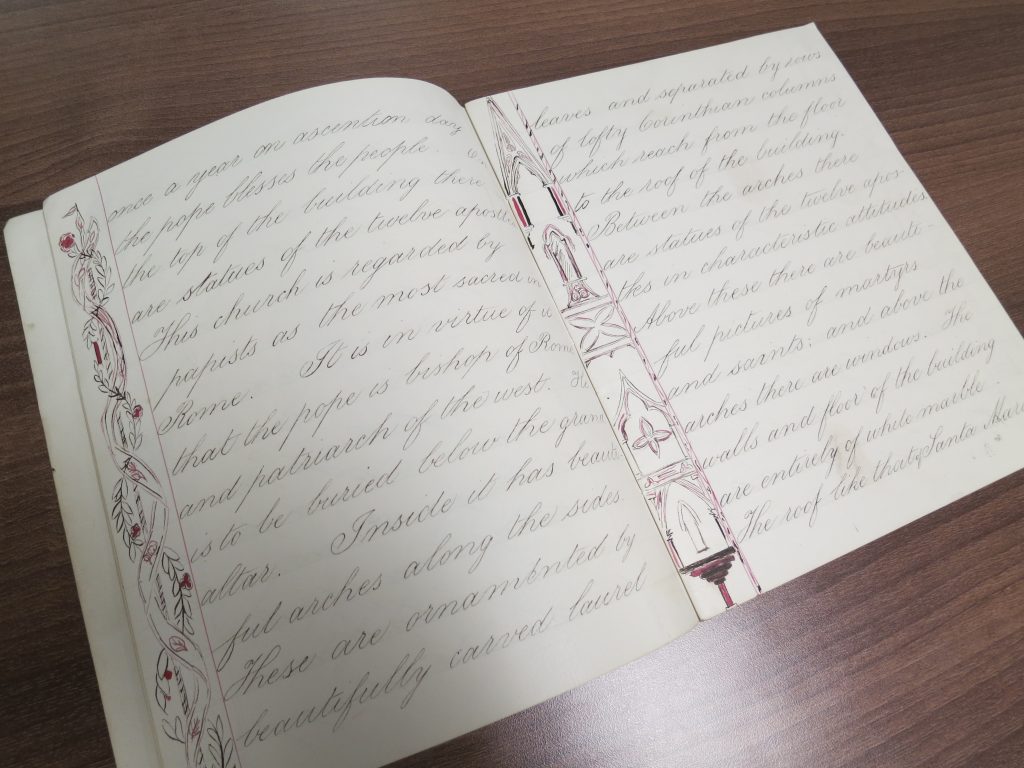
Doodles and copperplate handwriting from young Archy’s Continental Tour in 1870
Once they were back home, Archie wrote up the diary in his ‘best’ copperplate handwriting, and it survives today in the Archive of the University of Glasgow. The blue exercise books took him two or three months to fill, writing at his house in Clapham and also up in Scotland, where the Corbetts had a holiday home in the village of Cove, near Helensburgh on the west coast. The house was called South Park, and Archie spent many a happy summer there sailing and riding his Shetland pony (and probably going to church a lot if mother Sarah had anything to do with it). He also dabbled in art, as his own son Billy recalled years later: “On rainy Sabbaths my father was allowed to paint the more lurid episodes from the Old Testament through Grandfather’s liberalising influence. I suppose that grandmother sat frowning” 3. Cove is just a little way down the coast from the huge area of hills and forest that he would eventually purchase for the people of Glasgow.
Looking through the exercise books, you get a strong sense of the impact all those grand squares, churches and sculptures were having on a young mind (there are some lovely doodles of roman columns with flowery decoration in the margins), and it possibly comes as no surprise that when he decided to go to college back in London, it was Art School that attracted him. He went to study sculpture in Kensington, but I suppose he found that admiring art and practising it are very different things, because he didn’t stick with the course for long, and soon determined on a rather more commercially-orientated direction – by stepping into the new family business. Please see The Estates for an account of how Corbett went about building his 10,000 houses.
CAMERON CORBETT, POLITICIAN
Archibald was very hands-on when it came to making decisions about how the Corbett Estates were developed, and in places like Ilford he was famous as a house-builder. But to the wider world he was better known for his second career, as a politician.
Politics might seem a strange choice for a softly-spoken man who didn’t crave the spotlight. But it makes sense when you realize how strongly-held his views were, and how much he wanted to improve society. He’d decided very early on that being a Member of Parliament would give him the kind of national platform that was required to advance the causes close to his heart.
In 1884 at the age of just 28, he left the day-to-day running of the Woodgrange Estate in the hands of Messrs Strachan, Donald and Kydd (Scotsmen all!), and set off for Warwickshire, where he rented a house and set about making a good impression on the locals ahead of a by-election on the 3rd July. He stood as a Liberal and put up a good show against the Conservatives, but was defeated by 5,282 votes to 3,538.
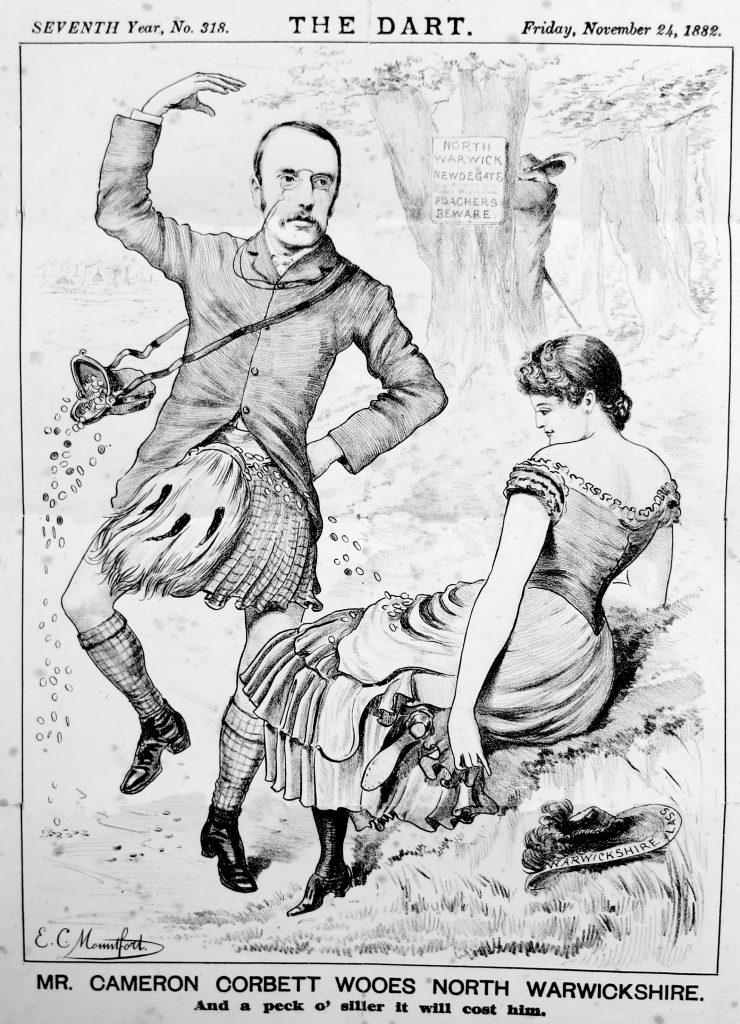
Archibald ‘splashes the cash’ in this satirical sketch of his attempt to get elected in Warwickshire
He tried again the following year, this time going back to the city of his birth, which had recently been divided into several new constituencies. He dropped ‘Archibald’ and called himself simply ‘Cameron Corbett’ (which presumably went down better amongst the Glaswegian electorate), and stood in Tradeston, close to his father’s old stomping ground of the Gorbals. This time he triumphed, winning 56% of the vote, and thus began a 25-year tenure as an MP, though a further seven elections.
Those elections weren’t all plain sailing though: a year after winning as a Liberal, he joined the breakaway Liberal Unionist Party, and stood for them instead. Later on in 1909, when the Liberal Unionists opposed a licensing bill that he supported, he left them too and campaigned as an Independent Liberal. His final election was in 1910 when he returned to the plain old Liberal fold and won for one last time. In 1911 he was given a peerage and moved to the House of Lords.
The main issue which drove him into politics was Temperance – abstaining from alcoholic drink. His father Thomas, you may recall, had been teetotal, and Archibald – or should that be Cameron – was convinced that society would be much improved if more people gave up drink altogether. He made this his main mission, and the Estates were in one sense a vehicle for his philosophy: by banning pubs and the sale of alcohol he hoped to instil temperance in the residents. Another route was in Parliament, where he had the chance to push for national changes through legislation. The two came together in a speech he made on the Liquor Traffic (Scotland) Bill in 1907, contesting the idea that people disapproved of a ban:
“The hon. Member who moved the rejection of the Bill had said there was no evidence that those who lived in prohibition areas were in favour of the system. I have some experience of my own prohibition area. I have never heard of any resolution being passed against the system, even by the smallest minority, and there have never been any representations made to my agents against the system. The area contains a large population of working people, and there is plenty of evidence that they were not dissatisfied with the principle of prohibition.
I venture to think that there is a vast amount of unanimity amongst the Scottish people upon this subject. The Corporation of Glasgow has passed a resolution in its favour, the city parochial authorities have passed a similar resolution, and so has the Govan Parochial Board. So, far from it being the case that a measure of this sort would not apply favourably to large towns, my belief is that the most favourable opportunity is to be found in the suburbs of our large cities.
Working men ought to be able to choose some part of a town to live in where their children are free from the temptation of the public-houses. The working classes have a right to neighbourhoods of their own which would be immune from the drink temptation which is so injurious to themselves and to their children”.
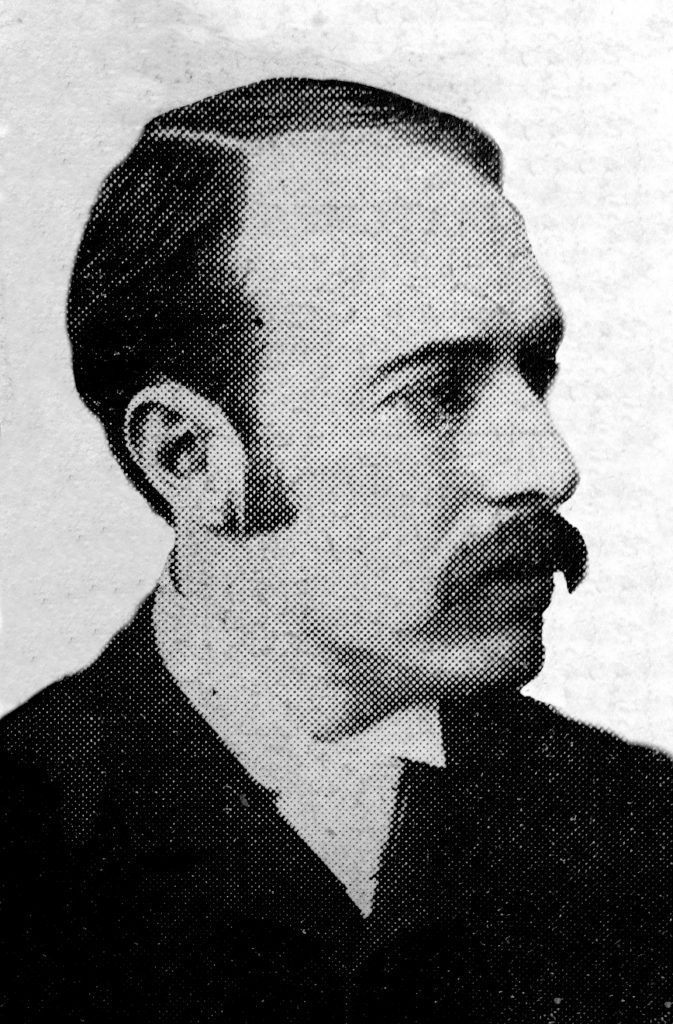
Cameron Corbett, Politician
He spoke in many debates to promote temperance, and must have had plenty of support for his views up in Glasgow, where he kept getting re-elected. But temperance wasn’t the only cause of his political career: he also devoted his energies to fight against Home Rule for Ireland; to promote Free Trade; to campaign for the rights of shop workers; and for women to be allowed to vote, amongst other issues. He wrote numerous letters to the papers – The Times primarily – and addressed endless public meetings. He sat on myriad committees, and lobbied those in power.
Home Rule for Ireland was the ‘Brexit’ of its day, dividing public opinion and political parties. The split caused in the Liberal Party by Prime Minister Gladstone’s support for Home Rule meant that he lost the 1886 general election heavily, and Corbett contributed to that defeat by joining the breakaway Liberal Unionists, who had allied themselves to the Conservatives.
Cameron made his views clear in a debate on a Government of Ireland Bill in 1893:
“In the present Bill, as it stands, absolutely the only safeguard the minority in Ireland will have would be the character and the sense of fair play of the Representatives of the majority of the people.
I believe that when the people of Scotland at last realise that the fate of their brother Presbyterians in the North of Ireland, has no stronger guarantee than the sense of fair play and the tolerance of the Representatives of the majority of the Irish people, they will be very slow to support a measure of this character.
In the future, if this measure is carried without Amendment, the Imperial Forces would be maintained to force men to obey laws which Englishmen believe to be unjust and cruel—laws which are in accordance with Irish ideas, but not in accordance with the ideas of the people of the United Kingdom, who, however, will still have the responsibility of enforcing those laws in which they do not believe.”
Being a staunch Presbyterian himself, Corbett presumably felt that not only were his ‘brothers’ in Ireland threatened by Home Rule, but Scotland’s place in the Union might also be less secure if they too got a measure of independence.
Free Trade was another issue close to his heart, and one that had long been a part of the Liberal tradition. Its adherents believed that it stimulated economic growth and stability, and Corbett wrote letters to The Times warning of the dangers of protectionism (the opposite of free trade) and the higher prices it would bring. He also cautioned against the ship-building industry giving preferential terms to British ship owners, or the government putting restrictions on the output of rubber plantations in colonial Asia (he freely acknowledged in the same letter that had held large investments in the shares of rubber companies).
Corbett was obviously a staunch capitalist, and a very successful one. The rise of the Labour Party in the early 1900s must have worried the capitalist class, but as his son recalls “when the first Labour Members entered parliament [in 1906] my father tried to help them in the acclimatization process. I shook hands with Will Crooks [one of their first MPs], known as the ‘Woolwich Infant’, after a large gun. He wore a thick black beard and was very kind to a small boy”. 22
By 1910 the warmth seems to have faded a little because Cameron went to a hustings event in Eltham, which was part of Will Crooks’ constituency, to speak in support of his Conservative opponent, a Major Adams. William Browning takes up the story: “We were part of the Woolwich Socialist district and I can well remember seeing Mr Corbett standing addressing the meeting wearing a large heavy gold watch chain – which I had never seen him wear before. He seemed to think his audience were antagonistic, and he threatened “If you Socialists get into power, we will take our money out of this country”. The audience, however, were nearly all our purchasers, and had come to see Mr Corbett in the flesh; and were very orderly and well-behaved.” 23
Socialism might not have been to his taste, but he very much wanted to help people all the same. One example of this was his campaign inside and outside Parliament for shorter working hours for shop assistants. This is from a debate in the Commons in 1892:
“With regard to the young persons employed in shops, the Act introduced by the right hon. Member for the University of London has given us some chance of judging the value of such legislation. The number of prosecutions of employers for keeping them too long hours show that boys of 14 have been employed as much as 90 hours a week—that is an average of 13 hours a day, for seven days a week.
The boys so employed are in a weak position, and it is difficult for them to come into a court of law and give evidence against their employers. We want the House to realise that after having provided that no young person shall be employed more than 74 hours a week, the responsibility is on it to see that the law is faithfully carried out.
If you want to see that is not carried out you want to go to the East End, where the usual hour of opening is 8 o’clock, and the boy who does the cleaning has to be there half-an-hour before; the hour for closing is 9.30pm.
We ask the House to pass this Bill, and secure for us that we shall have Inspectors to enforce the law. The boys and girls are afraid to give evidence, but if we have Inspectors they can collect evidence and see that the law is enforced. I trust that Members will realise that this is not a day when the House of Commons has a light responsibility, and that if young people are employed for 90 hours a week it is a matter which calls for the earnest and immediate attention of the House.”
Cameron was also chairman of the Early Closing Association, which pushed for a weekly half-day off for all shop-workers, and by 1892 it had signed up over 2,000 shopkeepers to provide the half-day on a voluntary basis. It might not seem much now, but to people on long hours it must have been like manna from heaven. He also practiced what he preached: on his Eltham estate he gave all the employees two weeks paid holiday – this was around 30 years ahead of the introduction of statutory holidays in 1938 (and even then the law only required employers to give one week).
Corbett also worked to promote the rights of women. His letters to The Times in 1908 include one that stresses the reasonableness of women wanting the vote, and in Parliament he protested at the treatment of suffragettes who’d been imprisoned, suggesting that it amounted to “political tyranny”. I presume he did a lot more behind the scenes, because Millicent Fawcett, who was the leader of the National Union of Women’s Suffrage Societies, sent him the following letter to applaud his becoming a Peer in 1911: “My dear Mr Cameron Corbett, I am writing to send my congratulations, but they are not entirely wholehearted, because we suffragists will miss you so much in the House of Commons. We all know that you will take your kind readiness to help our cause with you to the House of Lords, but our battle will be in the Commons yet for some time to come. Believe me, yours sincerely, M G Fawcett.” 24
Corbett clearly enjoyed being an MP. Although his central political mission – banning alcohol – was obviously never achieved, he couldn’t be accused of not giving it his best shot. And in a host of other areas, his campaigning zeal and quiet back-room efficiency had made real improvements to the lives of many people.
FAMILY MAN
So, Archibald had a successful business career, and was well into his stride as a politician. Now was the time, he felt, to settle down and start a family.
He’d actually met his future wife just after his abortive attempt to get elected in North Warwickshire, whilst he was on a vacation with the rest of the Corbett clan in Nice, in the south of France. His younger brother Harry met a couple called John and Mary Polson, fellow holidaymakers, staying nearby in Cimiez with their daughter Alice. Archibald was introduced and found he had much in common with John Polson, and also that he was attracted to seventeen-year-old Alice.
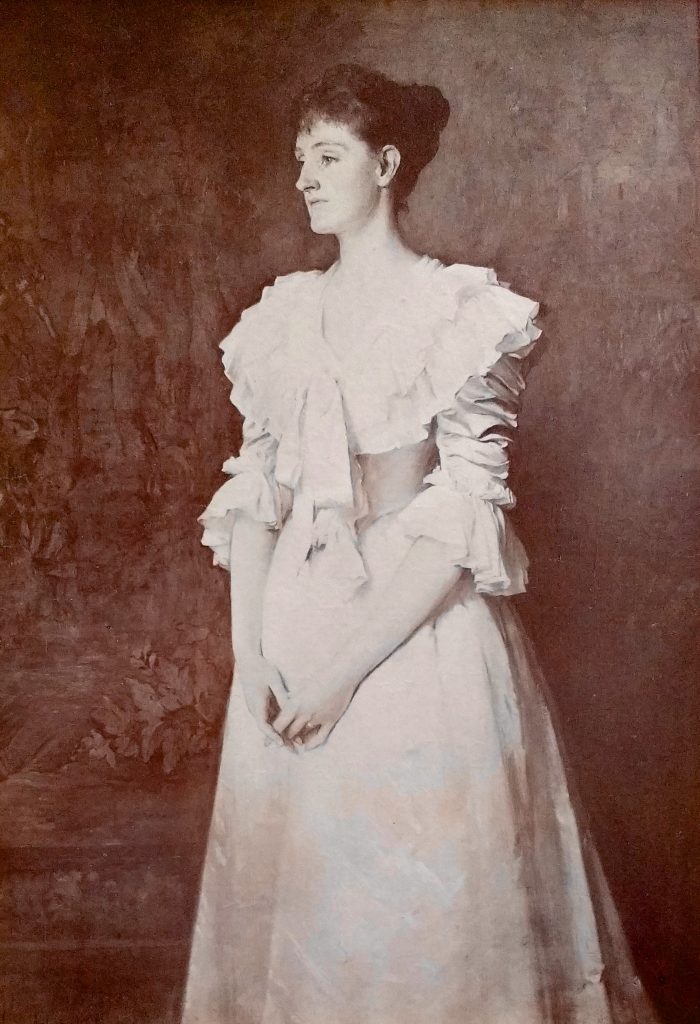
Alice Corbett, nee Polson
The Polsons were another rich Scottish family, whose fortune had been cemented by John’s invention of a process for making pure starch from maize. This process led to the creation of ‘Brown and Polson’s patent Cornflour’, a famous kitchen staple that he’d patented in 1854. They lived in Gourock near his company’s factory in Paisley, not far from Glasgow. An enlightened employer, John had built cottages for his workers, with bowling greens and tennis courts for their recreation. He’d also published a booklet on the evils of Monte Carlo, which Archibald would have presumably heartily agreed with, so there was plenty to talk about.
There’s no record of what Alice thought of Archibald, but the driven and eligible young man must have made quite an impression, because she was willing to wait a few years until he got his political career on track, and then marry in September 1887. The wedding took place in the village of Skelmorlie, just round the coast from Gourock and the Polson family home at West Mount (later name-checked by Archibald in a street on the Eltham Park estate).
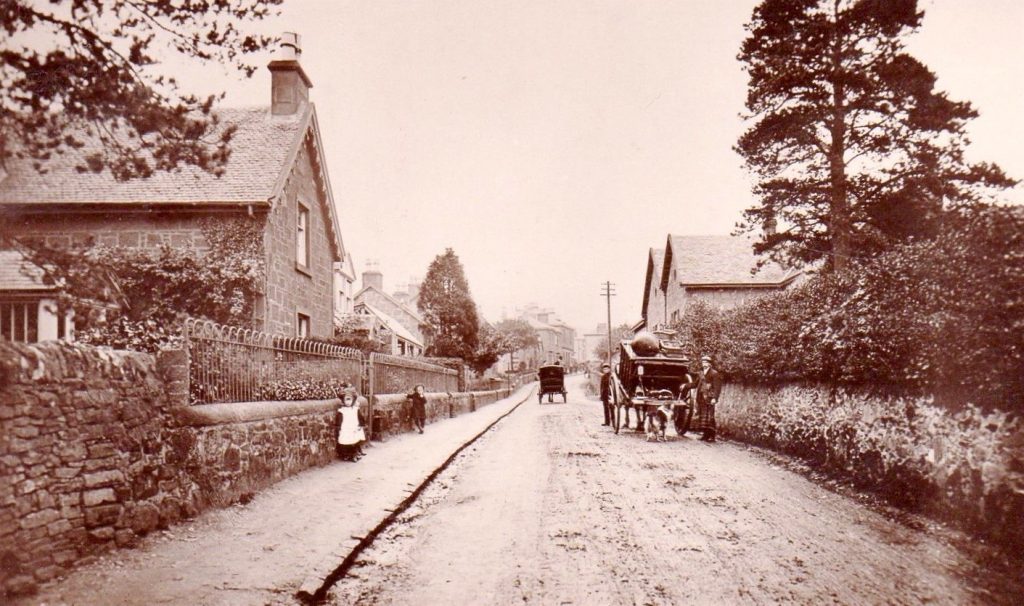
The village of Skelmorlie, where Alice and Archibald got married
With Archibald’s business interests down south, and his duties in Parliament, the newlyweds needed a house in London, and in 1888 moved into 26 Hans Place in Knightsbridge – a huge townhouse with a staff of servants to match. It was handy for the Corbett Estates main office in nearby Sloane Square. Three children followed: daughter Elsie was born in 1893, then Thomas (family name Billy) in 1895, and Arthur in 1898. Billy, who we’ve been hearing from throughout these pages, remembers what it was like as a child in Knightsbridge: “It was the London of horse-drawn cabs and grey streets lit by gas lamps with poverty and prosperity coexisting. Laden with honours, Victoria was approaching then end of her reign, and the sun shone on a safe Empire. Of course ours was an affluent existence, with servants and silver. My mother was an industrial heiress, and my father a property developer and Member of Parliament. But the Scottish blood in both gave them care and compassion.”
Childhood for Billy and the others sounds rather idyllic, with lots of trips up to Scotland to stay with Granny and Grandpa Polson: “The Cloch Lighthouse with its booming foghorn and bright rays was a popular picnic spot, among wild flowers at the bottom of the cliff. The scent of meadowsweet always acts as a stimulant to my memory, transporting me back in time in a series of mental snapshots, that many years have not faded…another place for a picnic was the hill towards the moor with the purple heather and its heady scent, and the white horses running free in the Firth below”.
Billy’s parents sounded a lot more involved with their offspring than many of the upper-classes were in Edwardian Britain: “Both my parents exercised a profound influence over their children as well as outsiders. Since my father’s upbringing had been narrow and his education scanty, he was determined that we should have the opportunities which he himself had missed. In conjunction with my mother, this meant the abolition of the Cameronian gloom of our lineage, but it also meant we had to think and act for ourselves, and not rely on parental management and money.” For the boys this meant no home tutors: Billy and Arthur went to prep school and then Eton. But sadly for Elsie the more enlightened regime didn’t extend to girls, so she was doomed to “education supplied by the dreary old governess in whose charge we were after my mother’s death, and who remained with us until I was eighteen” 25. Elsie describes herself as “desperately gauche and shy”, and without a proper education she felt very constrained:
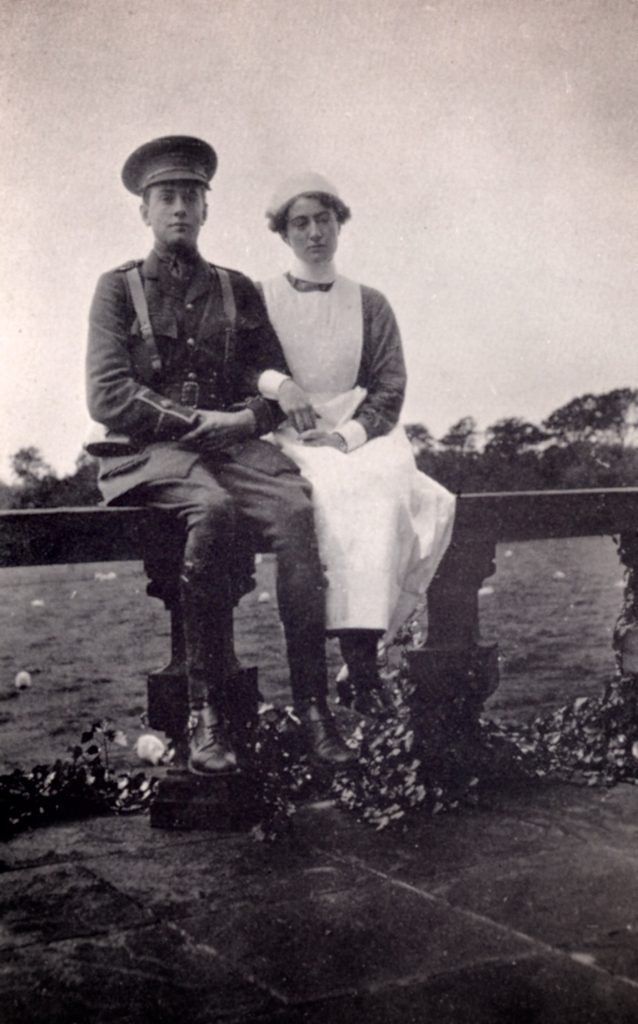
Billy and Elsie Corbett at Rowallan
“My father was an MP and a philanthropist, and my upbringing filled me with unconventional ideas and ideals but provided no outlet for them. Several of my mother’s friends became militant suffragettes and went to prison, several others were artists….I had been to a Cambridge May Week and had gazed with awe and reverence at Agneta Frances Ramsay, the first woman to qualify for a First Class Honours Degree, although she was not allowed to take it.”
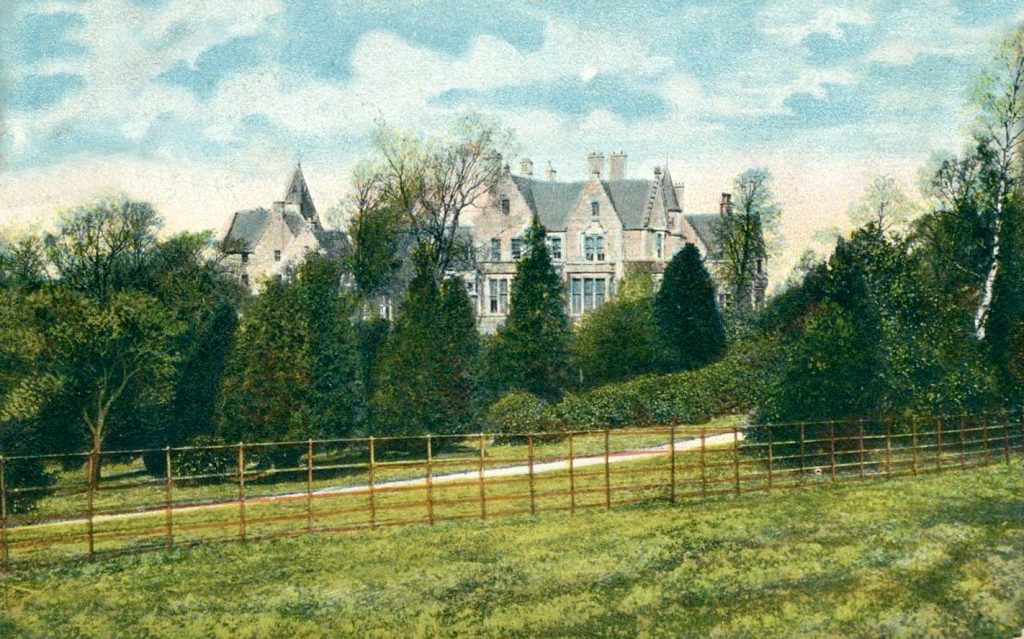
Thornliebank House
The Corbetts had also rented a house in Glasgow, called Thornliebank, six miles south of the city centre, from where Archibald could attend to his constituency business. This worked for a while – the family would hire a whole carriage complete with dining room for the train journey back to London – but its semi-rural setting was increasingly under threat from the advance of the big city (a process Archibald himself was a main contributor to in London of course), and the advent of the motorcar meant that they could look further afield for a permanent Scottish residence. In 1901, after the death of Grandpa Polson, they found a 6,000 acre estate in Ayrshire, called Rowallan, which the phenomenally wealthy Grandma Polson bought for them.
Archibald employed the pre-eminent Scottish architect of the day – Sir Robert Lorimer – to build a huge Scottish Baronial-style house next to the old Rowallan castle, and his life must have seemed nigh-on perfect: he was a successful businessman with a young family, enjoying his chance to influence the national debate, and now his dream home was under construction in the land of his forefathers.
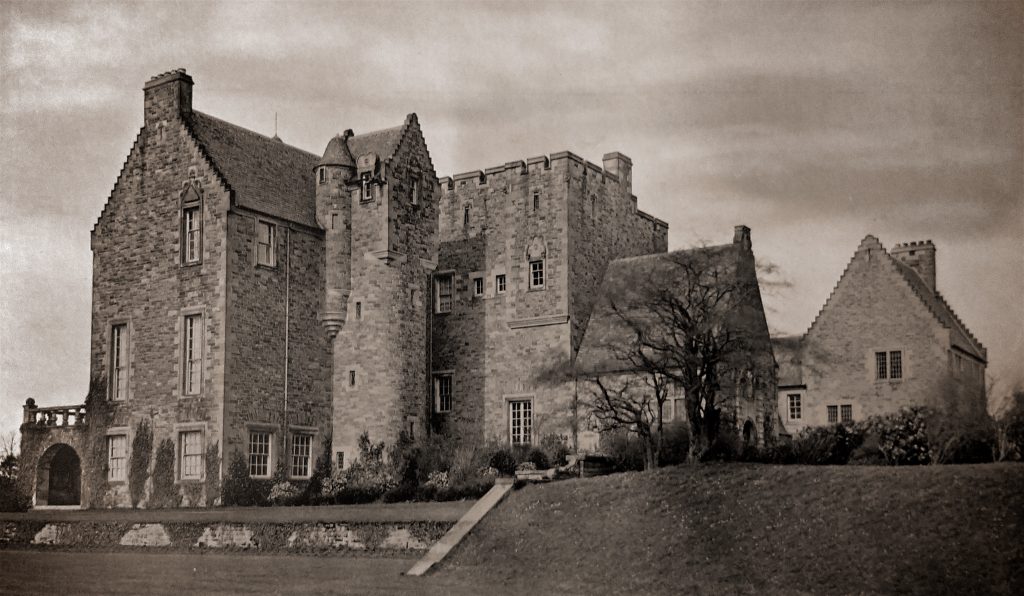
Rowallan in Ayrshire
But fate was about to deal a cruel blow. In July 1902, Alice and Archibald attended a meal in the City of London, and Alice fell ill soon afterwards. It seems a bone got stuck in her throat and led to septicaemia. Billy was just seven at the time: “After a short illness following a City dinner, our gay and adored Mother died. The blinds were drawn and Hans Place strewn with straw to muffle the hooves of the horses. The German bands fell silent and the hurdy-gurdy visited us no more”. His mother was only 34. Archibald sent the children away to Scotland and faced his grief alone in London.
The enormous Rowallan building project was nowhere near complete, and was almost abandoned by Mary because her daughter would no longer be living in it, but Billy believed she agreed to continue the funding so that his own family could live there one day. Archibald finally moved in in 1906. That made the rental property at Thornliebank redundant, but instead of terminating the lease, he bought the house and its extensive grounds, and gave them to the city of Glasgow as a public park – we’ll hear more about that soon.
As the three children neared adulthood, Europe was edging ever closer towards conflict, and when war was declared in 1914 they were all keen to do their bit. Billy describes his father as “the least martial man I knew”, but says that “he made no attempt to dissuade us…he knew the grave threats our small country faced from the mighty German war machine, and as a Corbett he was committed to a philosophy of service and sacrifice. So he stayed at home worrying, and holding the new ‘fort’ of Rowallan”. Billy cut his studies at Eton short and joined the Ayrshire Yeomanry.
Elsie had managed to get a Nursing Certificate (the lack of formal education meant her dream job of Doctor was unattainable), and this was her route out to adventure:
“One day, our old doctor, a friend of my father’s from his Warwickshire days, suddenly said to me ‘If you’re interested in nursing, why not go to Serbia? My son is running a hospital there; they’ve got a typhus epidemic and need nurses desperately’. It was as if an archangel had opened the gates of heaven to me. It was also the kind of outrageous proposition that appealed very much to my father. He suggested I should take a nurse from one of his hospitals with me…” 26 She arrived in spring 1915 and worked for the Red Cross in a Surgical Hospital and with a Scottish Motor Ambulance Column.
Arthur was only 16 and had to wait a couple of years before joining the Naval Air Service (a precursor to the RAF). He went for training in Eastbourne, and wrote several letters to his father:
“Dear Daddy,
We arrived here to find that nobody expected us so we had to wait at the station for about half an hour before a car came to take us away. We get leave every other weekend. I don’t know yet whether I will get off next weekend or the one after….Could you tell Dunhills my address for the coat? We go out to the aerodrome tomorrow…apparently we get lots of flying here…The house belongs to a dear old lady who calls us angels” 27
Arthur saw active service flying in France, but was shot down in 1916. His commanding officer wrote to Archibald: “Dear Sir, I regret to inform you that your son, Flight Sub Lieutenant A C Corbett was killed in action today as the result of a fight with hostile aircraft”. 28
It was devastating news. Archibald left Hans Place – presumably now too big and too full of memories – and loaned it to a group of Belgian refugees for the rest of the war. He moved into Browns Hotel in Mayfair, where he lived for the rest of his life.
After some hair-raising adventures in Serbia and a tortuous journey back to a French port, Elsie made it home: “We got on board the Normannia at midnight and were supposed to sail at once, but six boats had been submarined in the channel that day, so we had to wait till the destroyers did a bit of destroying. The third night we really sailed, and got to London at midday. I found Hans Place full of Belgians, but heard from McBean that everybody was alright and Dads was at Brown’s hotel”. 29
Billy got back too. He eventually fulfilled Grandma Polson’s dream by moving into Rowallan with his own family, and showed he was a true chip off the Corbett block by fighting in the Second World War, then becoming Chief Scout of the British Commonwealth and Empire, and finally Governor of Tasmania. He put his success down to the influence of ‘Dads’, as the family called Archibald: “Our respect for our father amounted to hero-worship, but he did not object, since he believed that men must look up to others for moral guidance, a philosophy I have faithfully tried to follow”.30
THE PHILANTHROPIST
There’s a telling phrase that Oswald Cole (who studied Corbett in the 1970s) picks out in a letter Archibald sent to Andrew Carnegie, the man who funded all the libraries, in July 1910: ‘Corbett asks Carnegie to consider the possibility of providing parks on lines of “business-like philanthropy”, and offers himself as a “volunteer helper…quite willing to take any charge you entrusted me with for the creation of Carnegie Parks”’ .31 The idea was to purchase cheap farmland in anticipation of development, and use most of it for parks – but also presumably make some money by selling some off at a profit for houses when it had risen in value.
Carnegie didn’t take him up on the offer, but Corbett’s phrase “business-like philanthropy” is most interesting, perhaps, when applied to the housing estates he created. He certainly made a lot of money out of them, so that’s not very philanthropic, but there’s no doubt he fashioned them to improve people’s lives both physically (no alcohol sales; clubs and recreational facilities; large gardens) and mentally (bringing ownership within reach of poorer people would, he felt, promote a spirit of self-reliance). He could probably have made more money without the ‘healthy-living’ agenda, but chose not to.
If you prefer your philanthropy totally untainted by profit, there are many examples of a more orthodox approach, which was directly related to his upbringing in a city that was proud of its willingness to help those in need. He donated an ambulance to Ilford in 1902 for example, and did charitable work in hospitals: “The Victoria Infirmary [in Glasgow] was on the boundary of his constituency, and we accompanied him on his rounds. There were quite a number of children on the wards, and at Christmas we took them presents and a tree with illuminations” 32.
He also tried to help deprived children in South Lambeth, where he handed out 2,000 hyacinth bulbs in glasses for them to grow so that they could gain an insight into nature. Closer to home, he gave presents to his employees: William Browning remembers “Mr Corbett, who had himself taken up cycling, presented very handsome new cycles to Mr Boyd and Mr Donald…and a fifty-guinea tea-set to James Pettigrew (son of his friend Robert) on his marriage” 33. Browning himself was offered the money to make a new start in America you may remember.
He made larger monetary gifts of £1000 (when £1000 counted for rather more than it does today) to the YWCA and to Glasgow’s Royal Samaritan Hospital, and I’m sure there were many other examples of lesser donations that aren’t recorded.
He gave his time too: for more than 10 years he was the well-respected, unpaid Chairman of the Conciliation and Arbitration Board for the steel trade in the west of Scotland, keeping the peace between management and the Unions, amongst many other committees he sat on.
But his biggest philanthropic projects were both of an outdoor nature, in keeping with his healthy living philosophy. Rouken Glen is the park created when he bought his rented mansion house, Thornliebank, plus 136 acres of surrounding land, and gave them to the city of Glasgow: “My usual provision against the sale of liquor will apply to this transfer” he cautioned the Lord Provost (Glasgow’s Mayor) when he handed it over in May 1906. Rouken Glen is still there – it’s a huge space with something for everyone to enjoy, including a boating lake and a woodland waterfall, and in 2016 it was voted Britain’s best park. It gets hundreds of thousands of visitors a year.
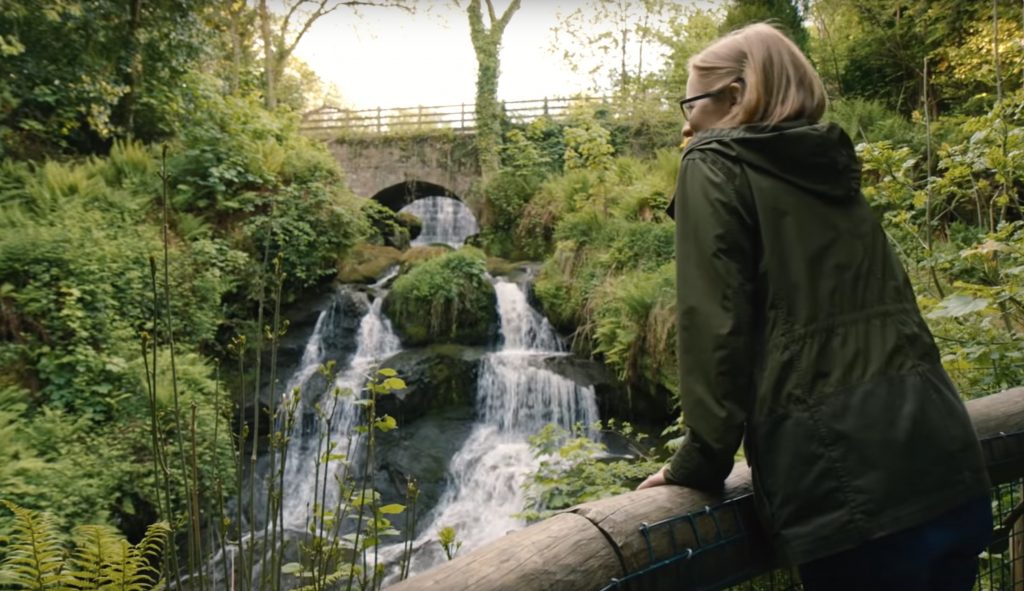
Rouken Glen Park in south Glasgow
Corbett went one better a month later when he handed over several farms he’d bought up in the southern highlands, around 40 miles from Glasgow, that constituted the ‘Ardgoil’ peninsula. It included the mountain of Beinn Ime and several smaller hills, and in his letter to the Lord Provost he said:
“My general object is to preserve a grand and rugged region for the best use of those who love the freedom of the mountains and wild natural beauty. While I would not object to the erection of simple cottages, I should greatly repel anything being done which would disturb the naturalness of such scenery, and would suggest that our artists might be consulted before any step affecting its aspect be taken. My usual clause against the sale of liquor would be a condition of the conveyance. I should also make it a condition that the revenue derived from the property should be diverted to the purpose of making it more accessible to our citizens, whether by ferry or other means”. 34
According to Billy, ‘It was my father’s wish that large numbers of mothers and children from congested areas of Glasgow should be taken to Ardgoil by steamer in the summer’. And they were! This gift of 15,000 acres made a large tract of wild land available to the public at a time when there were no National Parks – in fact it would be nearly 100 years before the Loch Lomond and The Trossachs National Park absorbed Corbett’s mountain territory.
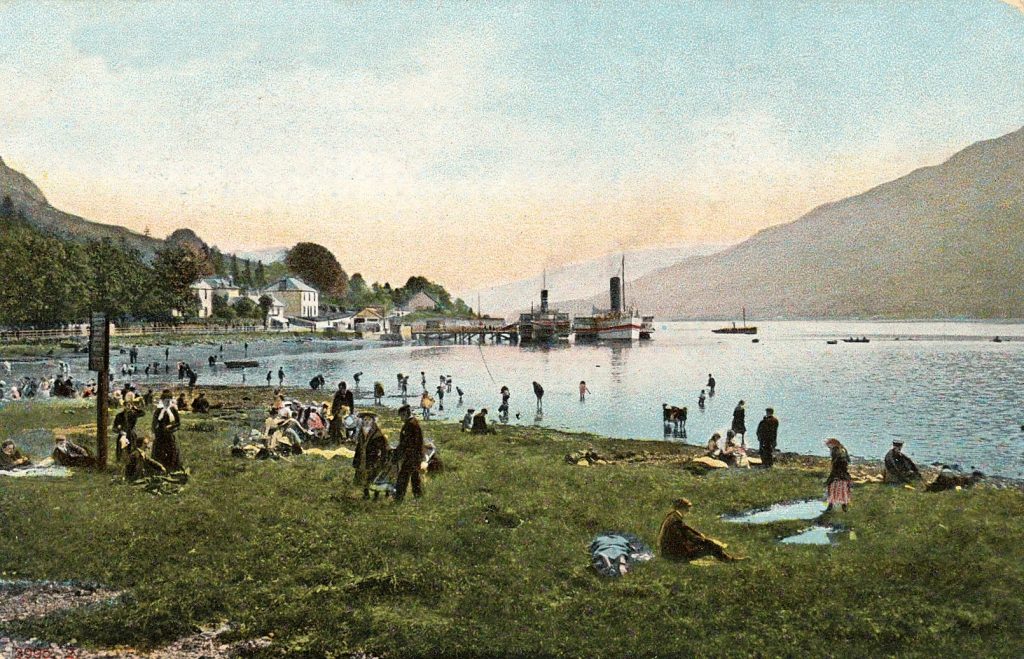
‘A huge wild garden’ – people from Glasgow on a day trip to Lochgoilhead, in Corbett’s Ardgoil peninsula.
Of course, Archibald wasn’t in the same league as philanthropists like Andrew Carnegie, John D Rockefeller, or George Peabody – he gave away tens of thousands, not millions, of pounds in gifts and cash. But where he does have a slight edge on the mega-philanthropists, is his humility: there’s no Corbett Trust or Corbett Foundation, and none of the estates or parks were named after him. In fact, you’d struggle to find anything physical that ties him to his creations, beyond a small plaque in the Torridon Road Library in Catford acknowledging his land donation, and an inscription on a drinking fountain a little way outside the Woodgrange Estate (the fountain was erected by local Methodists to make thirsty workers think twice before heading into a nearby pub, and was presumably funded by Corbett).
In his autumn years Archibald continued a quiet life in his Mayfair hotel, supporting pet causes and dividing his time between his gentleman’s club near Piccadilly, and the Houses of Parliament, where he delighted in running impromptu tours of the building for parties of schoolchildren and tourists: the story goes that they often wanted to tip the ‘kind old gentleman tour guide’, but a policeman guarding the palace was usually on hand to prevent any embarrassment.
A LEGACY
Archibald Cameron Corbett died peacefully on the 19th March 1933, whilst sitting in his chair at Brooks’s club, in London, aged 76. He is buried up in Scotland, on a moor near Rowallan, with his wife Alice and son Arthur.
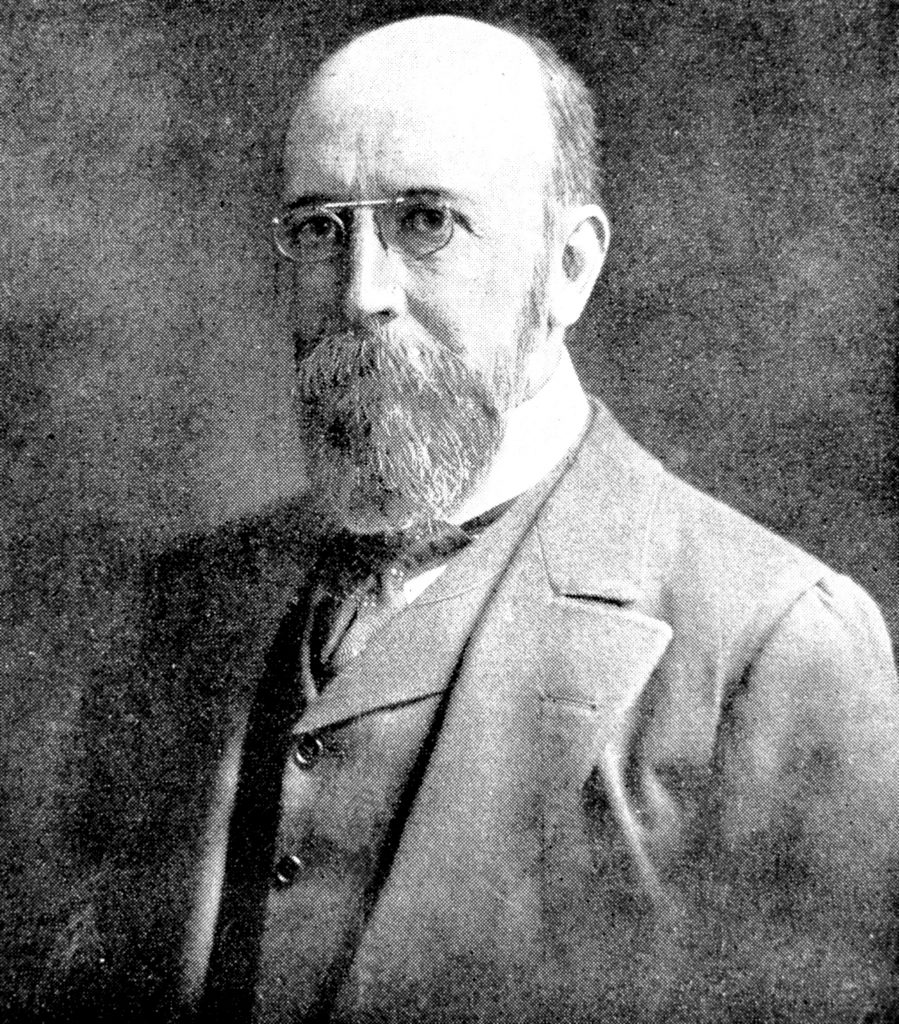
Archibald Corbett
Today he’s not a well-known figure, either in his native Glasgow, or on the housing estates he built in London. Given his reticence to add his name to any of his gifts – you won’t find an ‘Archibald Corbett Park’ anywhere for instance – and the length of time that has passed since his great building spree finished, it’s perhaps unsurprising that he’s slipped from public view.
Yet there’s enough information out there to allow us to peer behind the veil of time and come to some conclusions about the man and his mission.
We’ve seen that pretty much everything he did was underpinned by deeply-held religious views and a huge pride in his Scottish roots. Oswald Cole uncovered an account of a speech Corbett made in the Clementswood Estate, Ilford, which ties the two together. Archibald had been invited to lay the foundation stone for a Presbyterian church in Oakfield Road, and Cole reports that ‘He strikes to the heart of his audience by declaring straightaway that he is speaking as “an enthusiastic Scotsman and an enthusiastic Presbyterian” … that “the distinctive characteristics” of Scotsmen are “truth, sincerity and honesty”, and an attachment to a well-ordered democratic life. “Under conditions apart from Christianity we must have and always will have – selfishness, oppression, and the treading down of the weak by the strong”.35
He was a committed capitalist, capable of taking ruthless business decisions such as sacking an entire workforce, and he made a great deal of money through his business activities. The cynic might argue therefore that his ‘health-living’ ethos was just a clever marketing tool to entice people to live on his estates, but I would disagree: his deals with the railway companies (to open new entrances and build whole new stations) together with the well-built houses on offer, would have been more than enough to ensure their success. There was a genuinely philanthropic intent underlying the house-building, which isn’t negated by his financial reward.
Corbett’s more overt philanthropy – and there was a huge amount of it – was based around improving people, rather than simply helping them. He probably felt that there was a greater chance of long-term happiness if you addressed the root causes rather than applying a sticking plaster. I’m sure there would have been many who found this ‘I know what’s good for you’ attitude patronizing – particularly those who liked a drink! As the owner of the Long Pond, the first pub on a Corbett Estate commented (it was opened in 2014, long after Corbett’s covenants were deemed inapplicable) when asked about Archibald’s philosophy: “If I was around in those days I’d have told him what to do with it. There’s nothing worse than people preaching their views to other people”.36
But it’s hard to argue with much of his basic ethos: getting plenty of exercise in the fresh air is good for us; less densely-built housing with plenty of garden space does promote well-being; owning your own home can give you a sense of security that is good for the community as a whole.
One way or another, Corbett’s houses and parks have touched the lives of millions of people, and this legacy will be valued far into the future. I live on a Corbett Estate myself, and have come to appreciate the peace and quiet that he engineered into them – it’s still palpable today.
Billy Corbett said “My father was a man of ideas, and they usually succeeded”. I’m sure a lot of his thinking centred around how he could improve humanity further, and if the question is whether he advanced the causes of human health and happiness, I’d say yes, mission accomplished.
Written by ACS Secretary Ben Honeybone
References
1. Alan A Jackson, Semi-detached London: Suburban Development, Life and Transport 1900-39, 1991
2. Thomas ‘Billy’ Corbett, Rowallan, The Autobiography of Lord Rowallan, 1976
3. Ibid
22. Thomas ‘Billy’ Corbett, Rowallan, The Autobiography of Lord Rowallan, 1976
23. William Browning, The Corbett Estates, ‘Incidental Happenings’ unpublished memoir
24. Millicent Fawcett, letter to Lord Rowallan 21st June 1911, University of Glasgow Archive
25. Elsie Corbett, Red Cross in Serbia 1915 – 1919, 1964
26. Ibid
27. Arthur Corbett letter to his father 1916, University of Glasgow Archive
28. Letter from G.R. Bennet, Arthur’s Commanding Officer, December 4th 1916, University of Glasgow Archive
29. Elsie Corbett, Red Cross in Serbia 1915 – 1919, 1964
30. Thomas ‘Billy’ Corbett, Rowallan, The Autobiography of Lord Rowallan, 1976
31. Oswald Cole, The Quest for Cameron Corbett: A study of an Eminent Edwardian, Lewisham Local History Society 1973
32. Thomas ‘Billy’ Corbett, Rowallan, The Autobiography of Lord Rowallan, 1976
33. William Browning, The Corbett Estates, ‘Incidental Happenings’ unpublished memoirLetter from Corbett to Lord Provost of Glasgow, Wikipedia page on Ardgoil
34. Letter to Lord Provost of Glasgow from Archibald Corbett, author’s collection
35. Quoted in Oswald Cole, The Quest for Cameron Corbett: A study of an Eminent Edwardian, Lewisham Local History Society 1973
36. Michael Wren, landlord of the Long Pond, in the 2018 documentary Archibald Cameron Corbett: The Man and The Houses
Of all the sources, Oswald Cole’s 1973 The Quest for Cameron Corbett: A study of an Eminent Edwardian has been indispensable. I’m also indebted to Godfrey Smith, who wrote ‘Hither Green, the Forgotten Hamlet’ which got me interested in all things Corbettian; John Kennet who helped hugely with the Eltham Park Estate; Johnnie Corbett, 4th Lord Rowallan; and Roy Judge, who wrote ‘The Development of Hither Green from 1860’.